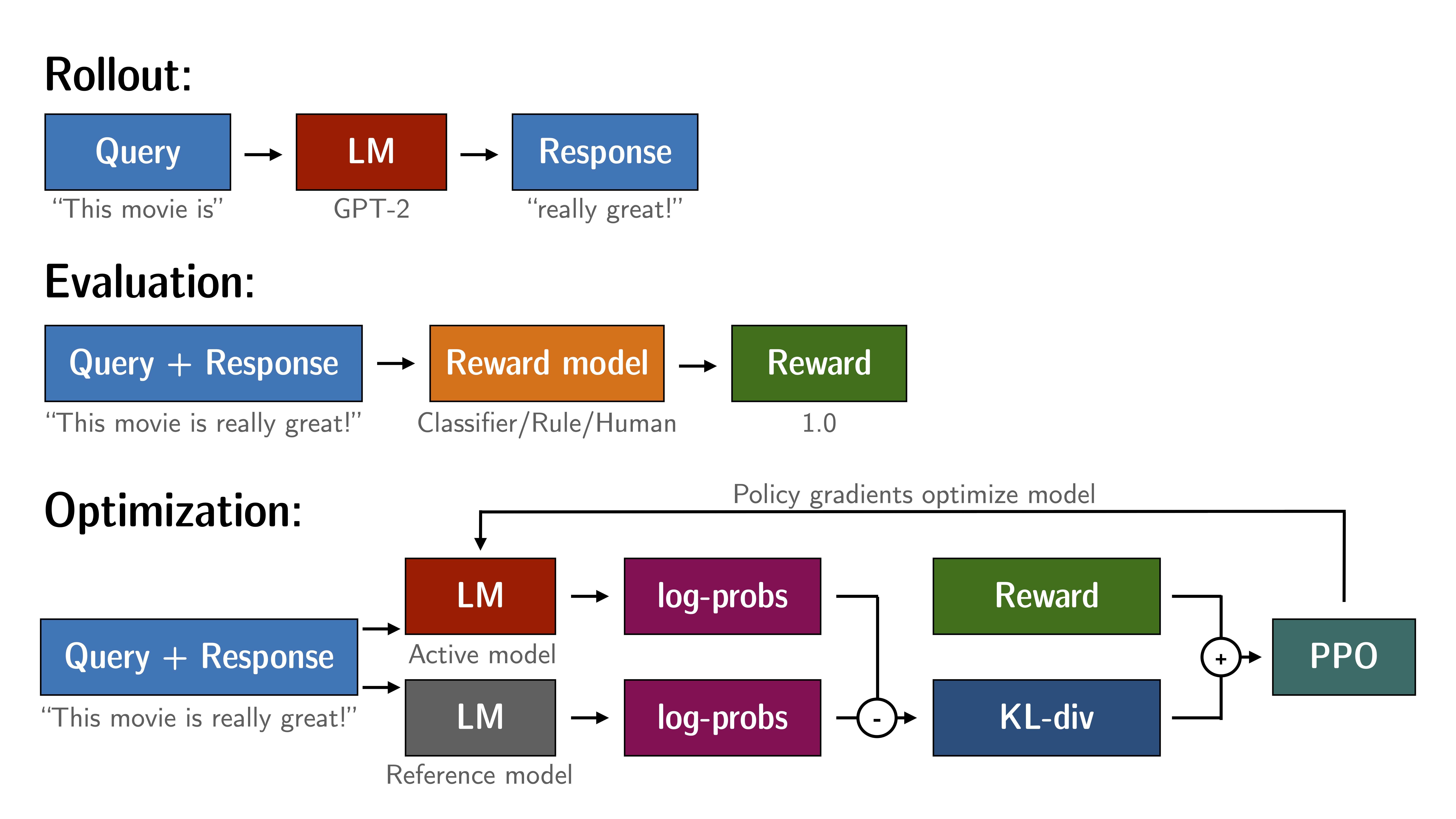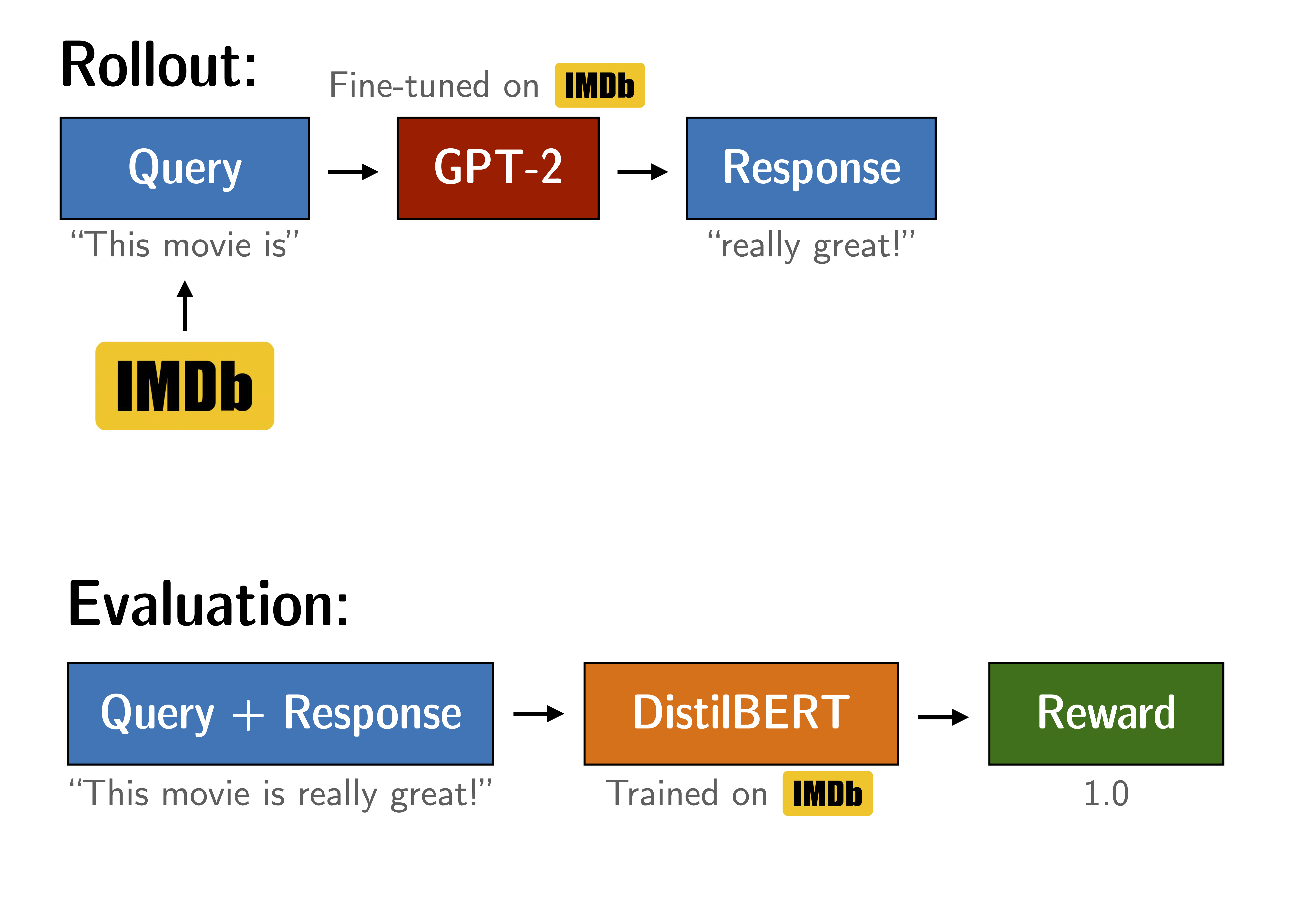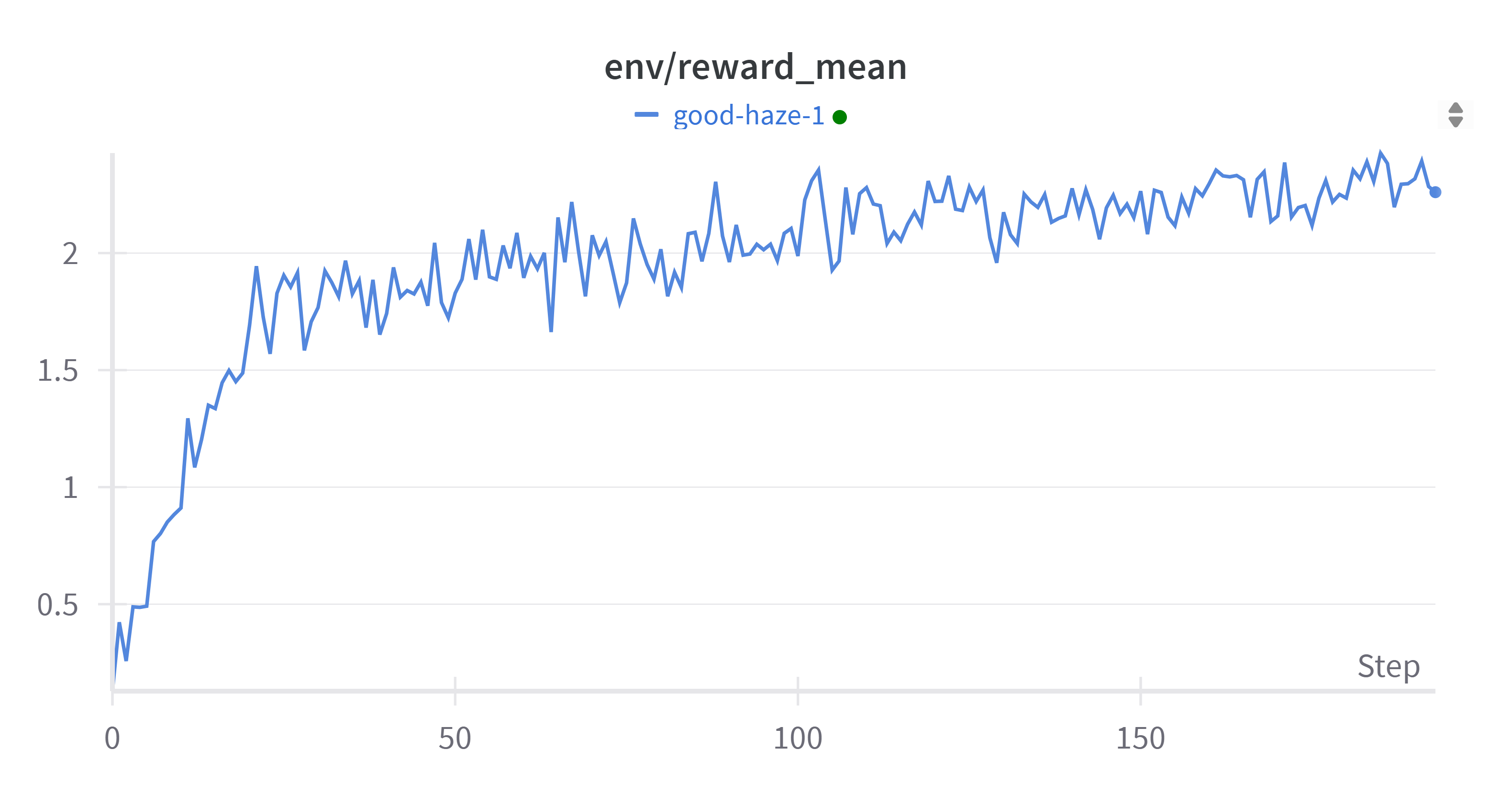动手学大模型:RLHF
文章摘要: 本文介绍了使用PPO(Proximal Policy Optimization)算法进行大模型RLHF(Reinforcement Learning from Human Feedback)训练的方法。重点展示了如何微调GPT-2模型生成积极电影评论的实验过程:1)通过BERT情感分类器作为奖励函数;2)使用IMDB数据集中的评论起始部分生成后续内容;3)利用分类器输出作为PPO训练的
动手学大模型:RLHF
PPO 如何运作
- Rollout:语言模型根据 query 生成响应。
- Evaluation:查询和响应使用函数、模型、人工反馈或它们的某种组合进行评估。此过程应为每个查询/响应对生成一个标量值。
- Optimization:在优化步骤中,查询/响应对用于计算序列中标记的对数概率。这是通过训练的模型和参考模型完成的。两个输出之间的 KL 散度用作额外的奖励信号,以确保生成的响应不会偏离参考语言模型太远。然后使用 PPO 训练主动语言模型。

微调 GPT-2 以生成积极评论
通过使用 BERT 情感分类器作为奖励函数,优化 GPT-2 以生成积极的 IMDB 电影评论。

我们微调 GPT-2 以基于 IMDB 数据集生成积极的电影评论。该模型会接收真实评论的开头部分,并需要生成积极的后续内容。为了奖励积极的后续内容,我们使用 BERT 分类器来分析生成句子的情感,并将分类器的输出作为 PPO 训练的奖励信号。
实验设置
下载模型和数据
数据集
export HF_ENDPOINT=https://hf-mirror.com; huggingface-cli download --resume-download stanfordnlp/imdb --local-dir dataset/imdb --repo-type dataset
参考模型
export HF_ENDPOINT=https://hf-mirror.com; huggingface-cli download --resume-download lvwerra/gpt2-imdb --local-dir model/gpt2-imdb
奖励模型
export HF_ENDPOINT=https://hf-mirror.com; huggingface-cli download --resume-download lvwerra/distilbert-imdb --local-dir model/distilbert-imdb
导入依赖项
# %pip install -r requirements.txt
# import os
# os.environ['CUDA_VISIBLE_DEVICES'] = '7'
import torch
from tqdm import tqdm
import pandas as pd
tqdm.pandas()
from transformers import pipeline, AutoTokenizer
from datasets import load_dataset
from trl import PPOTrainer, PPOConfig, AutoModelForCausalLMWithValueHead
from trl.core import LengthSampler
配置
config = PPOConfig(
model_name="model/gpt2-imdb",
learning_rate=1.41e-5,
log_with="wandb",
)
sent_kwargs = {"top_k": None, "function_to_apply": "none", "batch_size": 16}
import wandb
wandb.init()
你可以看到我们加载了一个名为 gpt2_imdb 的 GPT-2 模型。该模型在 IMDB 数据集上额外微调了 1 个 epoch,使用的是 Hugging Face 的脚本(无特殊设置)。其余参数主要取自原始论文《Fine-Tuning Language Models from Human Preferences》。该模型以及 BERT 模型均可在 Hugging Face 的模型库中获取,具体链接在这里。
加载数据和模型
加载 IMDB 数据集
IMDB 数据集包含了 50,000 条电影评论,并标注了“积极”/“消极”的情感反馈。我们将 IMDB 数据集加载到一个 DataFrame 中,并筛选出至少 200 个字符的评论。然后,我们对每条文本进行分词,并使用 LengthSampler 将其随机截断为指定长度。
def build_dataset(
config,
dataset_name="dataset/imdb",
input_min_text_length=2,
input_max_text_length=8,
):
"""
Build dataset for training. This builds the dataset from `load_dataset`, one should
customize this function to train the model on its own dataset.
Args:
dataset_name (`str`):
The name of the dataset to be loaded.
Returns:
dataloader (`torch.utils.data.DataLoader`):
The dataloader for the dataset.
"""
tokenizer = AutoTokenizer.from_pretrained(config.model_name)
tokenizer.pad_token = tokenizer.eos_token
# load imdb with datasets
ds = load_dataset(dataset_name, split="train")
ds = ds.rename_columns({"text": "review"})
ds = ds.filter(lambda x: len(x["review"]) > 200, batched=False)
input_size = LengthSampler(input_min_text_length, input_max_text_length)
def tokenize(sample):
sample["input_ids"] = tokenizer.encode(sample["review"])[: input_size()]
sample["query"] = tokenizer.decode(sample["input_ids"])
return sample
ds = ds.map(tokenize, batched=False)
ds.set_format(type="torch")
return ds
dataset = build_dataset(config)
def collator(data):
return dict((key, [d[key] for d in data]) for key in data[0])
加载预训练的 GPT2 语言模型
我们加载带有值头(value head)的 GPT2 模型和分词器。我们加载了两次模型;第一个模型用于优化,而第二个模型作为参考,用于计算与初始点的 KL 散度(KL-divergence)。这在 PPO 训练中作为额外的奖励信号,以确保优化后的模型不会偏离原始语言模型太远。
model = AutoModelForCausalLMWithValueHead.from_pretrained(config.model_name)
ref_model = AutoModelForCausalLMWithValueHead.from_pretrained(config.model_name)
tokenizer = AutoTokenizer.from_pretrained(config.model_name)
tokenizer.pad_token = tokenizer.eos_token
初始化 PPOTrainer
PPOTrainer 负责后续的设备分配和优化:
ppo_trainer = PPOTrainer(
config, model, ref_model, tokenizer, dataset=dataset, data_collator=collator
)
加载 BERT 分类器
我们加载了一个在 IMDB 数据集上微调过的 BERT 分类器。
device = ppo_trainer.accelerator.device
if ppo_trainer.accelerator.num_processes == 1:
device = 0 if torch.cuda.is_available() else "cpu" # to avoid a `pipeline` bug
sentiment_pipe = pipeline(
"sentiment-analysis", model="model/distilbert-imdb", device=device
)
Device set to use cuda:0
模型输出的是负面类和正面类的 logits。我们将使用正面类的 logits 作为语言模型的奖励信号。
text = "this movie was really bad!!"
sentiment_pipe(text, **sent_kwargs)
[{'label': 'NEGATIVE', 'score': 2.3350484371185303},
{'label': 'POSITIVE', 'score': -2.726576089859009}]
text = "this movie was really good!!"
sentiment_pipe(text, **sent_kwargs)
[{'label': 'POSITIVE', 'score': 2.557040214538574},
{'label': 'NEGATIVE', 'score': -2.294790267944336}]
生成设置
对于响应生成,我们仅使用采样方法,并确保关闭 top-k 和核采样(nucleus sampling),同时设置一个最小长度。
gen_kwargs = {
"min_length": -1,
"top_k": 0.0,
"top_p": 1.0,
"do_sample": True,
"pad_token_id": tokenizer.eos_token_id,
}
优化模型
训练循环
训练循环包括以下主要步骤:
- 从策略网络(GPT-2)中获取查询响应
- 从 BERT 中获取查询/响应的情感
- 使用 PPO 优化策略,利用(查询、响应、奖励)三元组
output_min_length = 4
output_max_length = 16
output_length_sampler = LengthSampler(output_min_length, output_max_length)
generation_kwargs = {
"min_length": -1,
"top_k": 0.0,
"top_p": 1.0,
"do_sample": True,
"pad_token_id": tokenizer.eos_token_id,
}
for epoch, batch in enumerate(tqdm(ppo_trainer.dataloader)):
query_tensors = batch["input_ids"]
#### Get response from gpt2
response_tensors = []
for query in query_tensors:
gen_len = output_length_sampler()
generation_kwargs["max_new_tokens"] = gen_len
query_response = ppo_trainer.generate(query, **generation_kwargs).squeeze()
response_len = len(query_response) - len(query)
response_tensors.append(query_response[-response_len:])
batch["response"] = [tokenizer.decode(r.squeeze()) for r in response_tensors]
#### Compute sentiment score
texts = [q + r for q, r in zip(batch["query"], batch["response"])]
pipe_outputs = sentiment_pipe(texts, **sent_kwargs)
positive_scores = [
item["score"]
for output in pipe_outputs
for item in output
if item["label"] == "POSITIVE"
]
rewards = [torch.tensor(score) for score in positive_scores]
#### Run PPO step
stats = ppo_trainer.step(query_tensors, response_tensors, rewards)
ppo_trainer.log_stats(stats, batch, rewards)
0%| | 0/194 [00:00<?, ?it/s]The attention mask is not set and cannot be inferred from input because pad token is same as eos token. As a consequence, you may observe unexpected behavior. Please pass your input's `attention_mask` to obtain reliable results.
4%|▍ | 8/194 [01:23<32:18, 10.42s/it]You seem to be using the pipelines sequentially on GPU. In order to maximize efficiency please use a dataset
100%|██████████| 194/194 [35:19<00:00, 10.92s/it]
训练进展
如果你正在使用 Weights & Biases 跟踪训练进展,你应该会看到类似于下图的曲线。查看 wandb.ai 上的交互式示例报告:链接。

可以观察到,经过几次优化步骤后,模型开始生成更积极的输出。
模型检查
让我们从 IMDB 数据集中检查一些示例。我们可以使用 ref_model 来比较优化后的模型 model 与优化前的模型。
#### get a batch from the dataset
bs = 16
game_data = dict()
dataset.set_format("pandas")
df_batch = dataset[:].sample(bs)
game_data["query"] = df_batch["query"].tolist()
query_tensors = df_batch["input_ids"].tolist()
response_tensors_ref, response_tensors = [], []
#### get response from gpt2 and gpt2_ref
for i in range(bs):
query = torch.tensor(query_tensors[i]).to(device)
gen_len = output_length_sampler()
query_response = ref_model.generate(
query.unsqueeze(0), max_new_tokens=gen_len, **gen_kwargs
).squeeze()
response_len = len(query_response) - len(query)
response_tensors_ref.append(query_response[-response_len:])
query_response = model.generate(
query.unsqueeze(0), max_new_tokens=gen_len, **gen_kwargs
).squeeze()
response_len = len(query_response) - len(query)
response_tensors.append(query_response[-response_len:])
#### decode responses
game_data["response (before)"] = [
tokenizer.decode(response_tensors_ref[i]) for i in range(bs)
]
game_data["response (after)"] = [
tokenizer.decode(response_tensors[i]) for i in range(bs)
]
#### sentiment analysis of query/response pairs before/after
texts = [q + r for q, r in zip(game_data["query"], game_data["response (before)"])]
pipe_outputs = sentiment_pipe(texts, **sent_kwargs)
positive_scores = [
item["score"]
for output in pipe_outputs
for item in output
if item["label"] == "POSITIVE"
]
game_data["rewards (before)"] = positive_scores
texts = [q + r for q, r in zip(game_data["query"], game_data["response (after)"])]
pipe_outputs = sentiment_pipe(texts, **sent_kwargs)
positive_scores = [
item["score"]
for output in pipe_outputs
for item in output
if item["label"] == "POSITIVE"
]
game_data["rewards (after)"] = positive_scores
# store results in a dataframe
df_results = pd.DataFrame(game_data)
df_results
| query | response (before) | response (after) | rewards (before) | rewards (after) | |
|---|---|---|---|---|---|
| 0 | Well I guess I know | that Cantor may be an | ..but I loved it | 0.230196 | 2.281557 |
| 1 | This is an excellent, | direct-to-video film with typical | enjoyable movie.<|endoftext|> | 2.846593 | 2.840860 |
| 2 | Now, I | 've never had the chance with James | loved the growing episode - and the | 0.656194 | 2.525894 |
| 3 | We tend | not to see Arthur | to like this very | -0.280880 | 2.183822 |
| 4 | The proverb "Never judge a book | by the cover" has caught on. After glancing t... | with high compliments, but it is recommended ... | 0.274649 | 2.065951 |
| 5 | I've never understood | why so many artsmen, | this film but it's delightful | 0.835574 | 2.782384 |
| 6 | Hugh (Ed Harris) is | an acclaimed "hero" and his fian | a wonderful actor who is a good adaptation | 1.580167 | 2.602940 |
| 7 | This particular Joe McDoakes | ' episode brought all the wrong bits and | movie is really a great movie. It | 0.870956 | 2.795245 |
| 8 | Sisters In | Vrooms 8.23, I signed up for all of the | The Universe 1: Sunny is cute, and has a cute... | 1.175259 | 2.062330 |
| 9 | I was very fond of this | film, it was obviously a bad idea when first ... | show, and know that I have seen it several times | 1.058164 | 2.511273 |
| 10 | If he wanted to be | funny, he could | a genius eventually, | -0.388943 | 0.405888 |
| 11 | Thats My | Grade...<br /><br />Although | Way was the best movie that I watched. | -0.151680 | 2.473050 |
| 12 | This is possibly the best short | film I have come across in almost two years. | film ever written. It has some very memorable... | 2.511835 | 2.775994 |
| 13 | Some people say this is | exactly what happens in Hollywood; where come... | a powerful film to listen to. It really captures | 0.637631 | 2.821085 |
| 14 | A remake of | "The Wizard of Oz | the legendary Kingan oil | 0.292409 | 0.434021 |
| 15 | What a terrible | movie!<|endoftext|> | chopping sounded so good, I love it! We have a | -2.681461 | 2.340650 |
通过观察生成序列的奖励均值/中位数,我们发现了显著的差异。
print("mean:")
display(df_results[["rewards (before)", "rewards (after)"]].mean())
print()
print("median:")
display(df_results[["rewards (before)", "rewards (after)"]].median())
mean:
rewards (before) 0.591666
rewards (after) 2.243934
dtype: float64
median:
rewards (before) 0.646912
rewards (after) 2.492161
dtype: float64
保存模型
最后,我们保存模型以供后续使用。
model.save_pretrained("model/gpt2-imdb-pos-v2")
tokenizer.save_pretrained("model/gpt2-imdb-pos-v2")
('model/gpt2-imdb-pos-v2/tokenizer_config.json',
'model/gpt2-imdb-pos-v2/special_tokens_map.json',
'model/gpt2-imdb-pos-v2/vocab.json',
'model/gpt2-imdb-pos-v2/merges.txt',
'model/gpt2-imdb-pos-v2/added_tokens.json',
'model/gpt2-imdb-pos-v2/tokenizer.json')
更多推荐
 已为社区贡献26条内容
已为社区贡献26条内容






所有评论(0)